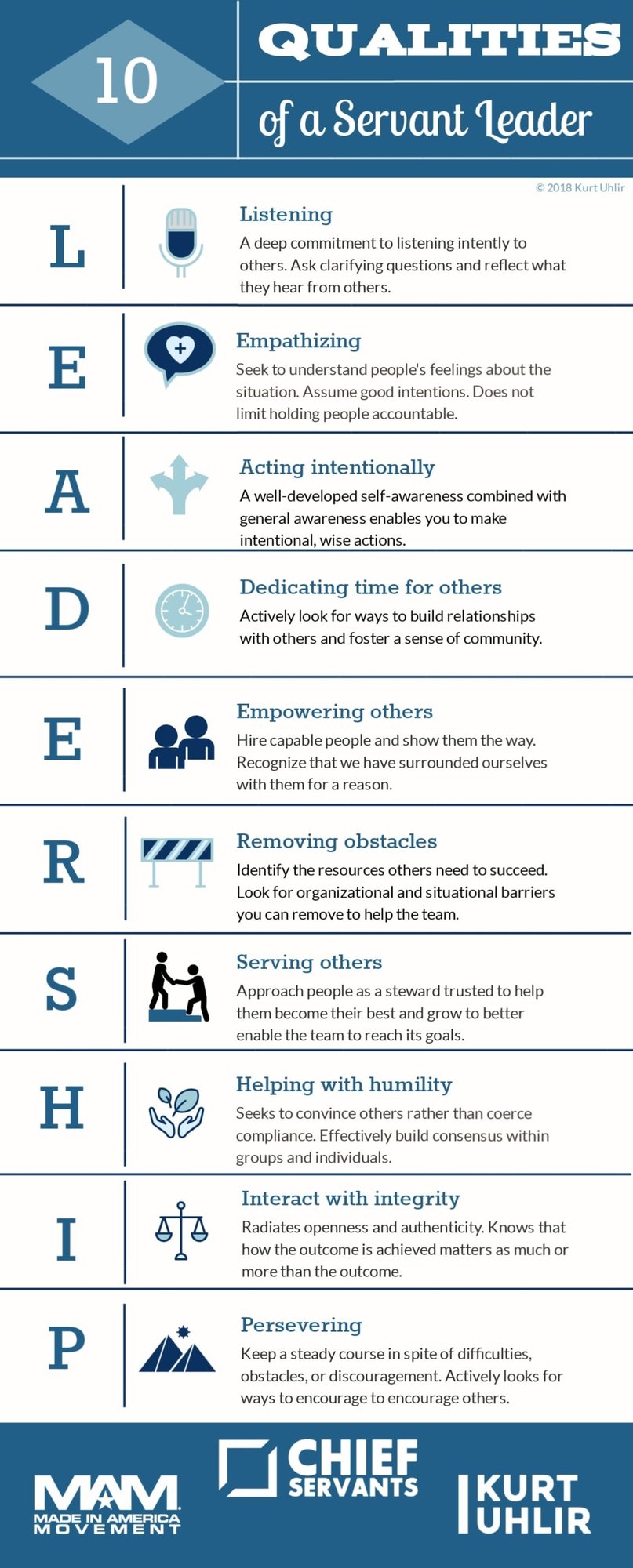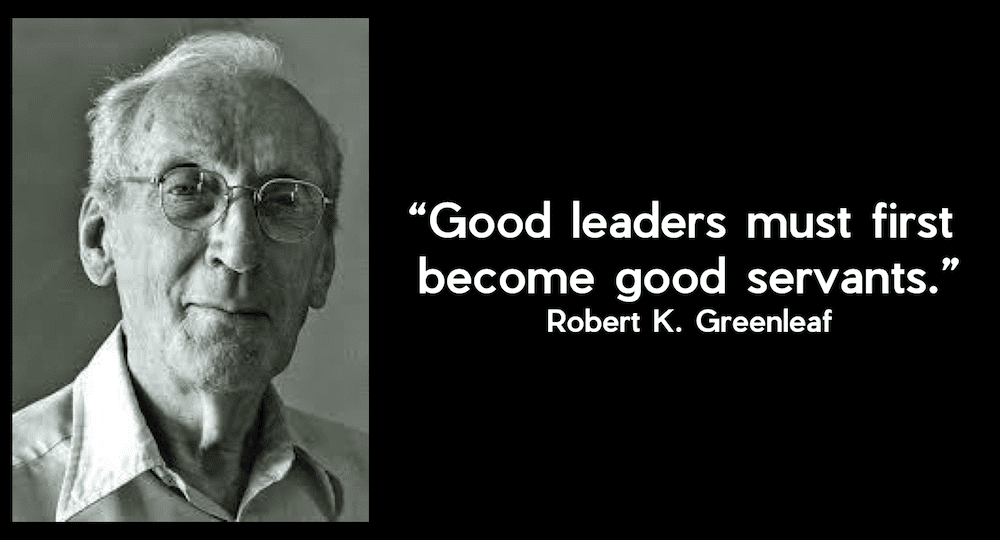10 Qualities of a Servant Leader {Infographic}
There are many so-called leaders in the world today. Yet, the best-known leaders and companies that have been successful for generations had a vital concept in common: they were servant leaders. Each one understood that value came not from the figurehead leading but from the average, everyday people who truly make a successful and enjoyable reality.
At your company, it is the front-line individuals that your customers interact with every day. A mission statement on a wall or your website does not directly impact the value and experience your customers get from the company. It is the product and services the company offers combined with the interactions, follow-up, and actions of your employees. This is what determines if customers are net promoters or net detractors.
In your church or non-profit, much is the same as with a for-profit company. How your organization carries out its missions is important to both the people you serve and the people that volunteer and work for our company. Having weak or subservient team members can hinder the organization’s success, as they may lack the individual strengths and independent thought necessary for effective outcomes. Bosses want people that will simply follow orders. Leaders want people that will help the organization reach desired outcomes. Strong, empowered collaborators are essential for achieving the organization’s vision and goals.
Servant leadership manifests in concrete actions, such as providing funds for professional development and encouraging employee involvement in decision-making, to nurture a sense of community and support among team members. Do not have the budget for professional development, then this may be seen by leaders stepping up to mentor others throughout the company.
At home, the results are clear. An authoritarian approach to raising children and interacting with your spouse may change your behavior in the short term, but will weaken your relationship in the long term. Leading your family through intentional servant leadership will not only help deepen your relationships. It will allow you all to grow more and create long-lasting life changes.

Put on your own site
<p style="text-align: center;"><a href="https://kurtuhlir.com/"><img class="aligncenter" src="https://kurtuhlir.com/wp-content/uploads/2018/07/10-Qualities-of-a-Servant-Leader-Infographic.jpg" alt="10 Qualities of a Servant Leader Infographic" width="700px" border="0" /></a>
<strong>Originally posted by <a href="“https://kurtuhlir.com”"> Kurt Uhlir - Innovation Expert and Servant Leader</a> and <a href="“http://www.themadeinamericamovement.com”"> The Made in America Movement</a> </strong></p>
<br>What Is Servant Leadership?
Servant leadership is not a term often heard, but it is essential to success and sometimes performs more as an unwritten rule. A servant leader sees his followers as his peers and focuses on attaining the end goal by supporting and encouraging those serving under and with them (from an org chart perspective). By providing the necessary support and encouragement, servant leaders foster emotional investment, leading to a motivated and passionate workforce, which is essential for maintaining a positive team culture.
The term Servant leadership comes from Robert Greenleaf. However, it can be traced back to Journey to the East, a novella by Herman Hesse, and even into the Bible through Jesus Christ, Paul, and many others.
Servant leadership is a leadership approach that prioritizes the needs of others
Servant leadership is a leadership approach that prioritizes the needs of others, focusing on serving and supporting team members to achieve their full potential. This approach requires discipline and a commitment to serving others, making decisions that benefit the organization as a whole. Servant leaders recognize that their role is not just to lead, but to serve and support their team members in achieving their goals.
It requires discipline and a commitment to serving others, making decisions that benefit the organization
Servant leadership requires a high degree of discipline and a commitment to serving others. Servant leaders must be willing to put the needs of their team members first, making decisions that benefit the organization as a whole. This requires a strong sense of empathy and understanding, as well as the ability to communicate effectively and build trust with team members.
What Are the 10 Characteristics of a Servant Leader?
Developing servant leadership characteristics can make you a more effective leader. However, it can be challenging to nail down a specific list to make a how-to guide to becoming a servant leader.
From my research into hundreds of servant leader based organizations and interviews with many different kinds of leaders from both SMBs to dozens of companies with multi-billion annual revenues, here are ten qualities consistently found in servant leaders. Empowering individuals is essential to prevent stagnation and ineffective outcomes.
These characteristics of servant leadership provide a basic outline of what you can do as a leader to focus more on those you are guiding.
1. Servant Leaders Are Empathic
A good leader, in general, is empathetic and relatable to the people they lead, but a servant leader is even more so. They consider how to walk a mile in the shoes of the people they encounter. What roadblocks inhibit them from accomplishing outcomes the company needs from them, and what are their personal goals? Good servant leaders create and cultivate healthy relationships with the people they serve and those who do not follow them. Lastly, they genuinely care for people.
Servant leaders understand that to work with a person, to lead them, they must understand them. While people are intrinsically unique, there are some ways that we are all similar. A leader will take the time to consider the ramifications and consequences of their actions on those that report to them. It’s not simply what they say but how they show up and are perceived.
Servant leaders also focus on healing relationships and addressing emotional wounds (often from past companies or bosses) to foster a supportive environment that unlocks employees true productivity.
The foundation of a leader or any organization is healthy relationships; people matter, especially the ones who represent people. I was trained (or rather re-trained) by mentors to say “Mission first, people always”. It is my goal for those on my teams to not just feel this but for it to be seen in their individual actions.
Toxic leadership poisons the whole congregation, organization, or company. Yet, someone who understands the people who work for and with them will cultivate a sense of success.
They care; to truly lead is to care and advocate, meaning that not only does the leader understand their people, but they also relate, emphasize, and care for them. It could be spiritual, mental, or professional, but the bottom line, a leader cares for the flock he shepherds.
2. Servant Leaders Prioritize Others Before Themselves
Another characteristic that describes servant leaders is that they consistently prioritize others before themselves. Servanthood stays open to helping the people around them in a self-sacrificing way that ensures employee well-being and helps sustainably encourage the team.
A servant leader is aware of what their people need. They keep an ear to the ground, prioritizing the things going on in the lives of the people around them.
While not everyone feels comfortable sharing everything at work, many do. If those on your team knew that your spouse recently fell terminally ill, had a child dealing with an issue with school or peers, how about if you recently chose to step into the role of caregiver for a family member, or you were taking hours to attend school for the next steps in your career, how would they react?
Teams work best when the people feel as though they are well-taken, cared for, understood, and valued where they are at.
While it may seem like a dangerous road, focus on putting people above yourself. A leader has to know healthy boundaries, so they can find the perfect balance for team. It is essential to understand the value of your workers to be a good leader and cultivate a thriving working environment.
3. Servant Leaders Are Excellent Listeners
It may seem like an unwritten rule that a quality leader is not just a good listener but an excellent one. Yet, this is one of those things that are easier said than done. It is hard to hear, while also intently listening in a way that makes people feel heard.
We need to be receptive to the ideas and inputs of others. No one is right a hundred percent of the time, and there is always someone who has better insight into a topic or a new fresh idea. Leaders are receptive to the conceptions of others.
The combination of ideas from the leader and the people they lead helps make better decisions – both those aligned with the best outcomes for the company and with the well-being of others. By carefully listening, you can improve their decision-making skills. Taking time to listen actively helps foster better judgment and logical thinking.
4. Servant Leaders Have the Gift of Foresight
No one is honestly psychic, but someone experienced enough knows how things will play out when they are familiar with the subject and protocol. Good leaders are well-versed in the environment around them and should be able to anticipate upcoming problems and crises.
I like to say that “there’s a muscle memory to scaling”. When you’ve been part of building high-growth company, it feels different. While you may not always know the best thing to do, you often have insights into poor decisions or actions based on history.
A leader must be confident in dealing with whatever arises quickly and concisely. Proactiveness nips problems in the bud, so to speak, by dealing with the problem immediately, so it does not spiral into something bigger and harder to deal with later on.
Part of leading is disciplining and providing the forethought necessary to keep things going well and the potential problems the team should consider ahead of time. Leaders are proactive when dealing with any potential stressors that might arise in the future.
Foresight allows leaders to assess the likely consequence of their decisions by understanding past experiences and current realities. This ability helps them anticipate future impacts and make informed choices.
I call this “healthy conflict”. If you want to avoid conflict, you can stay in your house and not talk to anyone, and that will buy you a short time of peace, but there is no way to avoid conflict in our work or personal lives. The question is how and when do you address the differences in opinions or decisions to be made.
This understanding is developed by closely analyzing past events and the present scenario. True leaders stay aware of the past and can apply it to the present as necessary.
5. Servant Leaders Admire & Espouse Integrity
Leaders with poor character often stay leaders for a short time or have an organization rotting from the inside out or at the very least, they have to lead different people because good team members will leave and go to different organizations.
Providing a healthy environment encompasses the idea of maintaining a sense of integrity within the organization as a whole and the individual people in it.
A country or business is only as good as the everyday people that make it up. Anyone that says “it’s business, not personal” clearly does not understand integrity or how business and personal affect each other. How we reach the outcomes may be more important than what outcomes the company achieves.
Leaders focused on servitude and stewardship admire integrity, support it in daily choices, and provide an example throughout their lives.
A quality servant leader is a person of good moral character, including a strong foundation of honesty. They are not afraid to take a stand on controversial issues, even when their opinion might be the unpopular minority. They are someone you want to follow. These types of leaders have a high confidence level in themselves, yet they never forget the contributions of others to their success.
6. Servant Leaders Are Awake & Reasonable
While sometimes there is too much of a desire for a leader to be “relatable” or “relevant,” there is always a need for a leader to be aware of what is going on around them. In most situations, heightened awareness allows leaders to understand various ethical and power dynamics, enabling them to view complex issues in a more integrated and holistic manner.
Servant leaders should not be hyper-focused on constantly changing to fit in the image of what is popular, but they should be able to see their vision as it fits into the world around them.
A leader must see the big picture to unlock success. It is challenging for the leader who wants everything to be perfect and notices all the little details, but a leader is the one who has to step back and see the whole, not just the parts.
The details are vital, but some parts will not be seen or looked for. Some things will have to change as time passes. While we would like transformation instantly and change starts with a single decision, true change takes time for us as individuals, longer for teams, and even more time for entire companies.
A leader should ensure that the organizational core moves in the correct direction. That is why servant leadership is often called in leadership literature as the optimal form of transformational leadership. Leaders must understand the balance of ethics and power and how that applies to their leadership style.
7. Servant Leaders Set Concrete Visions
A wishy-washy vision will consistently change the finish line. A vision that cannot be repeated back by everyone on the team is not likely to be reached, or will at least take much longer.
To reach success, there has to be a clear and achievable goal that everyone on the team understands and is in agreement with. A good leader provides their followers with a clear picture of the desired future by answering the what(s), why(s), and how(s).
All of this should be clearly and easily understood by the employees, investors, and people completely new to the mission.
A goal is not easily achieved, but possible through hard work and failures that lead to breakthroughs. A servant leader understands that letdowns and mistakes are not avoidable and are a fundamental stepping stone for learning to inspire success.
They bring their conceptualization abilities to the forefront by evaluating the synergy between long-term goals and short-term outcomes. Conceptualization is, by its very nature, essential for setting clear visions. Everything should focus on supporting the team to reach long-term outcomes.
8. Servant Leaders Value Persuasion Over Coercion
A good leader does not force those under them to conform to their standards, thinking, or process. Instead, tying back into their ability to listen with an open mind, a leader understands that there are different ways to do things than their own.
Persuasion and influence at a glance may seem like coercion, but they are very different! Coercion relies on force and unyielding standards. Persuasion is about genuine conversations about opinions and thoughts where people understand the direction of the leader is the best choice.
Leaders use flexibility and innovation in their decision-making processes to adapt and serve the needs of others, ensuring they remain relevant in their industries.
There are big differences between a boss and a leader. A leader understands that their team’s success largely depends on their followers’ willingness to buy into their vision. They will display a reliance on persuasion. Servant leaders understand that the people serving them have the idea of self-betterment through service. Traditional leaders follow a different approach that typically leads to higher employee turnover.
9. Servant Leaders Work to Build Communities
A servant leader creates a space where the whole team works together as a unit or family. It is more than just coworkers; they are trustworthy friends. Like the integrated integrity of a team, a leader builds trust by being honest with each team member and themselves.
Servant leadership suggests an emphasis on building community within organizations, focusing on nurturing individual growth and fostering a sense of belonging among employees. A community or a healthy work environment is essential to a positive workspace, which can boost productivity by as much as thirteen percent. That is because this positive space allows creativity to thrive and for new ideas to be formulated without fearing a negative response.
If your company has to impose a “no assholes policy”, your way too late. There is NO reason not to be nice. Plus, the business outcomes are better if your nice. Focus on building community.
An organization will grow as the people who make it up grow both professionally and personally. How can you ever hand things off to those on your team if you do not train them and help them develop new skills.
Servant leaders are committed to seeing the people they serve grow. Not only is it mutually beneficial, but servant leaders genuinely care for the people under them, and growth is naturally good.
While some companies create formal mentoring programs, companies with a high-performing servant leadership culture will naturally create mentoring and disciplining relationships across all levels. An organizational life with high levels of trust and a commitment to growth will be known for community building.
When Judson Green, a 19-year veteran executive of Walt Disney Co. who served as Chairman of Walt Disney Attractions and CFO of the Walt Disney Co., joined NAVTEQ as CEO, he secretly (without HR knowing) selected me and nine other low-level employees for a unique mentoring relationship, if we kept up our agreement. He knew that negative information often gets filtered out when it moves upwards in an organization and that the company would benefit if he could get a transparent view into the company, so he required 1) that we always provide unbiased transparent information when he asked questions and 2) confidentiality to our relationship. I cannot tell you how many things I learned by sitting at his desk working and being able to listen in on his calls/meetings and watching him lead.
10. Servant Leaders Are Stewards of Healing and the Growing, Evolving Culture
The concept of stewardship is not as popular now as it once was, but that does not change the fact that it is still valid. A steward is someone who manages something, not their own (e.g. an employee of a company) for the benefit of the owner. A good steward takes care of what they are in charge of.
A leader realizes that success is only attained when people are free to strive for it. There has to be something that motivates people to not only complete the tasks given but to work hard and do their best.
If you’ve hired good, smart people, why would you not trust them to make decisions and weigh in on options that leadership should consider?
A servant leadership style is geared toward building and maintaining healthy relationships, which function as motivation and create the opportunity to build more incentives. Altogether, they work for the greater good by cultivating a sense of belonging and unity among the team members.
11. Servant Leaders Build Consensus and Collaboration
Servant leaders recognize the significant roles that consensus and collaboration play in achieving organizational success. They understand that by working together, individuals can accomplish far more than they could alone. This collaborative spirit is fostered through open communication, active listening, and empathy.
A servant leader empowers team members by encouraging them to take ownership of their work and the outcomes of their individual actions.
They provide the necessary resources and support to help their team succeed. This approach not only builds a sense of community but also creates a shared purpose within the organization.
By involving stakeholders in the decision-making process, servant leaders ensure that diverse perspectives are considered. They seek input and feedback from others, using this information to inform their decisions. This inclusive approach leads to better decision-making, increased innovation, and a more positive work culture.
In practice, a servant leader might hold regular team meetings where everyone is encouraged to share their ideas and opinions. They might also create cross-functional teams to tackle specific projects, ensuring that different departments collaborate and learn from each other. By building consensus and collaboration, servant leaders create an environment where everyone feels valued and motivated to contribute their best.
12. Servant Leaders Show Respect and Gratitude
Servant leaders understand the profound impact of showing respect and gratitude to their team members and stakeholders. They recognize that every individual has value and worth, and that each person brings unique strengths and perspectives to the table.
Demonstrating respect involves actively listening to others, valuing their opinions, and treating everyone with dignity and kindness. A servant leader shows gratitude by acknowledging and appreciating the contributions of others. This can be as simple as a heartfelt thank you or as significant as public recognition of a job well done.
By showing respect and gratitude, servant leaders create a positive and supportive work environment. This leads to increased job satisfaction, employee engagement, and retention. Moreover, recognizing and rewarding outstanding performance fosters a culture of excellence and continuous improvement.
For example, a servant leader might implement a peer recognition program where team members can nominate each other for their contributions. They might also provide opportunities for growth and development, celebrating the successes of their team members. By building trust and loyalty through respect and gratitude, servant leaders cultivate a more positive and productive work culture, strengthening the sense of community and shared purpose within the organization.
13. Servant Leaders Excel in Decision Making and Innovation
Servant leaders excel in decision making and innovation, using their wisdom and experience to make informed decisions that benefit the organization. They are able to think critically and strategically, considering the likely consequences of their decisions and taking calculated risks to drive growth and innovation. Servant leaders are also able to encourage and empower their team members to think creatively and develop new ideas, fostering a culture of innovation and experimentation.
14. Servant Leaders Focus on Performance and Growth
Servant leaders focus on performance and growth, recognizing that the success of the organization depends on the success of their team members. They are committed to helping their team members develop their skills and abilities, providing encouragement and support to help them achieve the outcomes those individuals were brought on to accomplish. Servant leaders are also able to provide constructive feedback and coaching, helping their team members to identify areas for improvement and develop strategies for growth and development.
How Can One Develop These Qualities & Become a Servant Leader Through Concrete Actions?
While all these characteristics of servant leadership are great on paper and are the hallmarks of a great servant leader, it is easier to say them than to take and apply each of these ideal qualities to everyday life. It is also crucial to avoid keeping weak team members and instead foster strong, empowered individuals. We’re all growing and we all have weaknesses. So what practical ways can a person work toward being a better servant leader?
Be Receptive to Opinions and Criticism
The basis of being a good leader starts by opening up and allowing for honest listening skills to others. Demonstrating listening skills is essential to setting an example and helping foster meaningful relationships.
Leaders need to attend to concerns and address the questions and opinions of their followers with genuine honesty.
Be Curious
To grow in any aspect is to ask questions, be curious, and not be afraid to look a fool a few times to create a solid foundation to build on. A leader has to get a feel for what the people they serve want.
Appreciate the Contributions of Others & Look Beyond the Hype
A leader takes into account the contributions of the people around them. They should acknowledge the people behind the curtain and see the truth behind the trends and excitement.
Learn to Surround Yourself With Inspirational People
The people around you inadvertently affect the trajectory of your life, including how you respond to situations now and all the little aspects of your life. Leaders understand that the first step in cultivating loyalty is acknowledging and affirming team members’ concerns. By doing so, they surround themselves with supportive people who encourage them daily to improve.
⇒ For more on this and to learn how to surround yourself with this type of person, listen to my conversation on Thought Hustle titled Billion Dollar Business & Billion Dollar Friends. I share some of what I learned from Don Wisniewski, Reggie Bradford (deceased), and Regi Campbell (deceased)
Value Integrity & Ethics
A leader always maintains an excellent moral character that is above reproach. Anything less and there will be discrediting questions and other issues that arise. Stay true to a high moral character.
Be Aware
Leaders are aware of what happens within their scope of authority and outside of it. This awareness encourages them to see possible problems in advance and improve the experience of dealing with them.
Don’t Forget
We learn many things the hard way. Learning from those severe failures sets us up for more incredible things tomorrow. Failure helps us get one step closer to success.
Can you and should you learn from failure? Absolutely, but it’s also health to remember that it was failure. That will help you avoid those choices and outcomes in the future.
Empower Others
Let people grow, and this means that sometimes they have to fail. However, how we deal with failure and support those hurting defines us. Your team will NOT do everything as well as you do or as well as they will do in five years, in 10 years, but you MUST let them start attempting, iterating, and improving today or they’ll be no more valuable to the team in the future.
Encouragement fosters emotional investment and motivation, which are essential for maintaining a positive team culture. This delicate balance of true leadership encourages direct reports to speak up when there may be personal biases or past emotional hurts hindering management from seeing the true issue.
Create a Sense of Belonging & Unity
People work best in situations where they feel comfortable, valuable, and appreciated. A leader should work to cultivate a space where people feel like they belong and fit in with the people around them.
Remember, there is a difference between unity and uniformity. When there is unity, people tend to tolerate and accept differences, but uniformity implies that everyone is alike, so there is no room for differences – and there is no room for growth
Nurture Trust
A toxic company will never be successful or keep people the way a company with healthy relationships and environments do. This revolves around being honest, even when it is unpopular. Build trust through consistent actions and backing up your words by precisely stating what you said.
Managing risk through ethical considerations is crucial in building trust. By fostering foresight and strategic planning, leaders can reduce organizational risk over the long term. This conscious choice to keep a reliance on persuasion and understanding issues consistently results in more value for customers, which ultimately benefits owners in the long-run too. It’s no wonder the principles of servant leadership are outperforming traditional leadership models.
Put Others First
A servant leader continues to put others first. They may sacrifice sleep and meals, maybe cut into personal time, but this self-sacrifice shows people the kind of person you are and whether you are trustworthy. But remember to keep healthy boundaries within this! Do not burn yourself out or overextend.
While my Dad was in the hospital before he passed, I asked him why I did not ever recall him taking a bite until others on the table did. His answer “Dad always eats last, his job is to make sure everyone else has what they need first”. That applies for anyone in a leadership role. How would your team look if everyone was trying to “outserve each other”.
Always Dare to Serve
Service may seem scary and daunting to someone not used to it. Yet, the rewards of service far outweigh any discomfort or struggle. Recognizing the special qualities of individuals fosters collaboration and helps in creating a supportive environment. Helping people naturally makes us feel better while encouraging the people around us. It puts every team member in the role as the “primary shaper” of the corporate culture and creates a true community focused on achieving the company’s purpose.
Servant Leadership in Action
Servant leadership is not just a theoretical concept, but a practical approach to leadership that can be applied in a variety of contexts. Servant leaders can be found in all types of organizations, from large public companies to private equity backed companies to non-profits to government agencies and community groups.
What will you see in the best marriages? Two people trying to out serve each other.
Next Steps in your Servant Leadership Journey
The practical next step is to put into place these qualities right away. You may fail a few times, but this opens the door for professional growth. There is no time like the present to start. The longer you put something important off, the easier it is to never start.
Want an implementation plan to roll out servant leadership for your company or just a more in-depth guide for your personal career growth? Click here for my guide The Business Case for Servant Leadership: Why It Outperforms Traditional Leadership.
Final Thoughts
It is daunting to begin something completely new, and for many people and companies, this approach to leadership is completely the opposite. Combined into the new concept of high-achieving servant leadership, we are creating a quiet revolution in business as investors understand the “strengths of servant”.
This is even scarier because it ties into character and everyday living. But the rewards from focusing on servant leadership are exponentially worth it if you want to grow your company and make your family or community a better place.
FAQs
Here are some of the most frequently asked questions about servant leaders and their leadership positions.
What is the greatest strength of a servant leader?
The greatest strength of servant leaders is their focus on the relationship between them and the people they serve and their value of teamwork and the growth of their workers.
A close second is an emphasis on persuasion and using this essential skill to build worker involvement.
What is the central goal of a servant leader?
A servant leader focuses on providing essential support to their employees through service, trust, and the desire for growth.
Who developed the servant leadership theory?
Robert K. Greenleaf gets credit for the term servant leadership theory, but this timeless concept is found throughout history, especially in the Christian Bible and other cultures.
Larry C. Spears is often credited with caring the torch in expanding servant leadership models, additional leadership studies, and helping many companies learn the clearest distinctions between this approach and the authoritarian model. Ken Blanchard is another notable figure in this personal development type of leadership.
What motivates a servant leader?
A servant leader is motivated primarily by encouraging positive growth toward the end goal and facilitating healthy conflict. This leader imparts wisdom to foster team growth, sharing sage advice and insights to help the team adapt to various situations and make ethical business decisions. They share power and are fearless in doing things often considered “below them” to succeed.
In the current reality, this management style avoids many of the personal issues, work-life balance concerns, and unlimited liability seen in so many major institutions.
Can a leader be a “servant”?
A leader can be a servant, but it differs from regular leadership ideology in that a servant leader does not see themselves above the people they are in charge of. They do whatever is necessary to help their organization succeed. This will look different from traditional leaders and will lead to the growth of employees with a deep commitment and genuine desire to help the organization fulfill its purpose.











